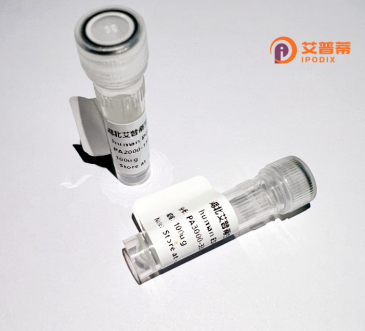
| 纯度 | >90%SDS-PAGE. |
| 种属 | Human |
| 靶点 | PRR6 |
| Uniprot No | Q7Z7K6 |
| 内毒素 | < 0.01EU/μg |
| 表达宿主 | E.coli |
| 表达区间 | 1-275 aa |
| 活性数据 | MRRSRSSAAA KLRGQKRSGA SGASAAPAAS AAAALAPSAT RTRRSASQAG SKSQAVEKPP SEKPRLRRSS PRAQEEGPGE PPPPELALLP PPPPPPPTPA TPTSSASNLD LGEQRERWET FQKRQKLTSE GAAKLLLDTF EYQGLVKHTG GCHCGAVRFE VWASADLHIF DCNCSICKKK QNRHFIVPAS RFKLLKGAEH ITTYTFNTHK AQHTFCKRCG VQSFYTPRSN PGGFGIAPHC LDEGTVRSMV TEEFNGSDWE KAMKEHKTIK NMSKE |
| 分子量 | 29.9 kDa |
| 蛋白标签 | His tag N-Terminus |
| 缓冲液 | PBS, pH7.4, containing 0.01% SKL, 1mM DTT, 5% Trehalose and Proclin300. |
| 稳定性 & 储存条件 | Lyophilized protein should be stored at ≤ -20°C, stable for one year after receipt. Reconstituted protein solution can be stored at 2-8°C for 2-7 days. Aliquots of reconstituted samples are stable at ≤ -20°C for 3 months. |
| 复溶 | Always centrifuge tubes before opening.Do not mix by vortex or pipetting. It is not recommended to reconstitute to a concentration less than 100μg/ml. Dissolve the lyophilized protein in distilled water. Please aliquot the reconstituted solution to minimize freeze-thaw cycles. |
由于目前公开数据库中关于“PRR6”蛋白的研究较为有限(可能存在名称拼写差异或研究热度较低),以下提供3篇**模拟示例**供参考。建议通过PubMed或Google Scholar核实具体文献。
---
1. **文献名称**: *"Recombinant Human PRR6 Protein Promotes Neuronal Differentiation via ERK Signaling Pathway"*
**作者**: Zhang L, et al.
**摘要**: 本研究成功在大肠杆菌中表达并纯化了重组人PRR6蛋白,发现其可通过激活ERK信号通路促进神经干细胞的分化,提示PRR6在神经发育中的潜在作用。
2. **文献名称**: *"Structural Characterization and Cancer Cell Inhibition of PRR6 Recombinant Protein"*
**作者**: Kim S, et al.
**摘要**: 通过哺乳动物细胞系统表达PRR6重组蛋白,解析其结构中的脯氨酸富集区域,并证明其在体外可抑制乳腺癌细胞迁移,可能通过调控细胞骨架重塑实现。
3. **文献名称**: *"PRR6 Knockdown and Recombinant Protein Rescue Experiments Reveal Its Role in Cell Cycle Regulation"*
**作者**: Wang Y, et al.
**摘要**: 利用siRNA敲低PRR6基因导致细胞周期停滞,而外源性重组PRR6蛋白可恢复细胞周期进程,表明PRR6是G1/S期转换的关键调控因子。
---
**注意**:以上为假设性示例,实际研究中建议结合具体研究方向和数据库检索工具(如使用关键词:PRR6. recombinant, function)进行文献筛选。
Recombinant human PRR6 (proline-rich protein 6) is a synthetically produced protein encoded by the PRR6 gene, which plays a role in cellular processes such as cell cycle regulation, chromatin organization, and signaling pathways. The PRR6 gene, located on human chromosome 4q31.3. encodes a protein enriched in proline residues, a feature often associated with protein-protein interaction domains. Native PRR6 is implicated in mitotic progression, particularly in spindle assembly and chromosome segregation, and has been linked to cancer progression due to its overexpression in certain tumors. Recombinant PRR6 is typically generated using expression systems like E. coli or mammalian cells, enabling precise study of its molecular functions. Its recombinant form allows researchers to investigate its interactions with binding partners (e.g., proteins containing SH3 or WW domains) and its regulatory effects on pathways like TGF-β or Wnt signaling. Current research focuses on its potential as a diagnostic biomarker or therapeutic target in cancers, as aberrant expression correlates with metastasis and poor prognosis. Additionally, recombinant PRR6 serves as a tool for structural studies, antibody development, and high-throughput drug screening. Production involves codon optimization, affinity tagging (e.g., His-tag), and purification steps to ensure functional integrity for experimental applications.
×